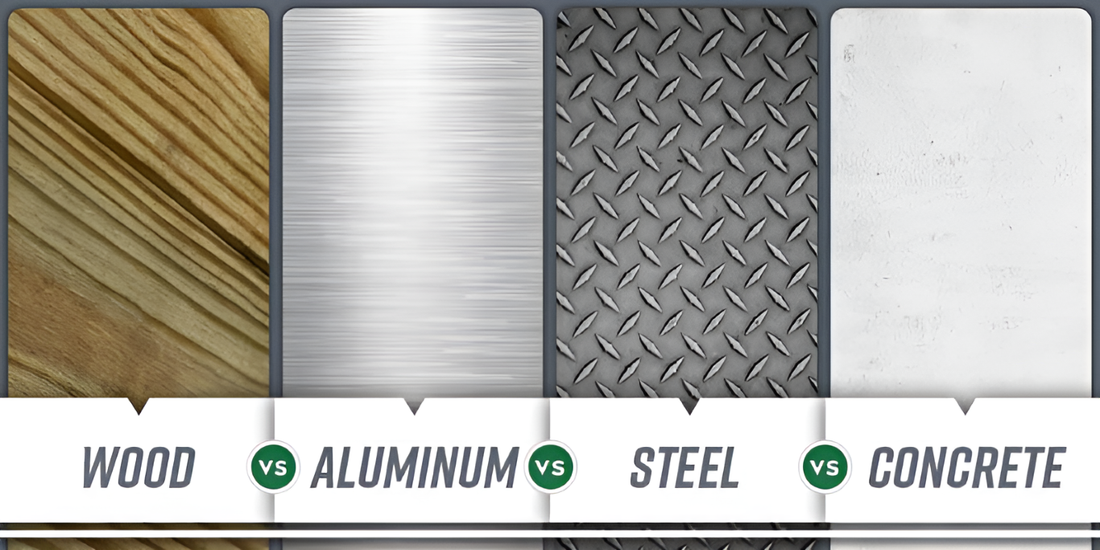Choosing the Right Material for Your Commercial Ramp
When procuring a commercial-grade ramp, selecting the right material is crucial for durability, safety, and cost-effectiveness. The four most common materials used for commercial ramps are wood, aluminum, steel, and concrete. Each has its own advantages and drawbacks, depending on factors such as climate, maintenance requirements, and long-term usage.
If your ramp needs to be relocated in the future, a modular solution made from a material like aluminum may be the best choice. For permanent structures, materials such as steel or concrete could be more suitable. Outdoor ramps must also withstand the elements while requiring minimal maintenance. Below, we explore the pros and cons of each material and the best use cases for each.
What Are the Different Types of Ramp Materials?
1. Wood Ramps

Pros:
-
Generally the most affordable option upfront.
-
Provides a natural, aesthetically pleasing look that some property owners prefer.
-
Can be customized to fit unique dimensions and site conditions.
Cons:
-
Requires significant labor and tools for construction, increasing installation costs.
-
Susceptible to rot, warping, and insect damage, requiring frequent maintenance.
-
Slippery when wet unless treated with non-slip coatings or tread tape.
-
Shorter lifespan compared to metal or concrete alternatives.
-
Removal and disposal can be costly and labor-intensive.
Best for: Temporary ramps in residential settings or low-traffic areas where aesthetics are a priority.
2. Aluminum Ramps

Pros:
-
Lightweight and modular, allowing for quick assembly and relocation.
-
Corrosion-resistant, making it ideal for outdoor and high-moisture environments.
-
Minimal maintenance—just occasional cleaning.
-
High strength-to-weight ratio, providing durability without excessive bulk.
-
Comes with a permanent, slip-resistant surface and smooth, continuous handrails for added safety.
Cons:
-
Higher upfront cost than wood ramps.
Best for: Commercial buildings, healthcare facilities, homes, and businesses needing low-maintenance, ADA-compliant access solutions.
3. Steel Ramps

Pros:
-
Extremely strong and durable, capable of handling heavy loads.
-
Can be customized to fit a variety of architectural needs.
-
Provides a solid, permanent solution for commercial and industrial applications.
Cons:
-
Prone to rust and corrosion, especially in humid or coastal environments.
-
Requires regular maintenance to prevent deterioration.
-
Heavy and difficult to install or relocate.
-
Higher labor costs due to weight and installation complexity.
Best for: Industrial settings or high-traffic commercial applications where strength and durability are top priorities.
4. Concrete Ramps

Pros:
-
Highly durable with an extended lifespan.
-
Can handle extremely heavy traffic and weight loads.
-
Requires little maintenance beyond occasional crack repair.
Cons:
-
Expensive and time-consuming to install due to the need for proper mixing and curing.
-
Prone to cracking and deterioration over time, especially in areas with freeze-thaw cycles.
-
Difficult to modify or remove once installed.
-
Limited customization options, as it must be designed to fit the existing infrastructure.
Best for: Permanent installations in high-traffic areas, such as schools, hospitals, and government buildings.
Why EZ-ACCESS® Chooses Aluminum for Commercial Ramps
At EZ-ACCESS, we specialize in modular aluminum ramps because they offer the best combination of strength, durability, and ease of installation. Our ramps are built to withstand the elements and heavy traffic, ensuring long-lasting accessibility with minimal maintenance.
Key Benefits of EZ-ACCESS Aluminum Ramps:
✔ ADA-Compliant – Designed to meet accessibility standards.
✔ Modular Design – Quick and easy to install, relocate, or expand.
✔ Corrosion-Resistant – Perfect for outdoor environments.
✔ Slip-Resistant Surface – Enhanced safety for all users.
If you're looking for a customized aluminum ramp solution for your business, contact our team today to explore the best options for your commercial application.
Get in Touch: EZ-ACCESS Customer Service

